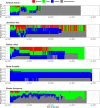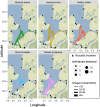Multispecies fish tracking across newly created shallow and deep habitats in a forward-restored lake
- PMID: 37501192
- PMCID: PMC10373381
- DOI: 10.1186/s40462-023-00405-1
Multispecies fish tracking across newly created shallow and deep habitats in a forward-restored lake
Abstract
Background: Freshwater fish communities typically thrive in heterogenous ecosystems that offer various abiotic conditions. However, human impact increasingly leads to loss of this natural heterogeneity and its associated rich fish communities. To reverse this trend, we need guidelines on how to effectively restore or recreate habitats for multiple fish species. Lake Markermeer in the Netherlands is a human-created 70,000-ha lake with a uniform 4 m-water depth, steep shorelines, high wind-induced turbidity, and a declining fish community. In 2016, a forward-looking restoration project newly created a 1000-ha five-island archipelago in this degrading lake, which offered new sheltered shallow waters and deep sand excavations to the fish community.
Methods: In 2020, we assessed how omnivorous and piscivorous fish species used these new habitats by tracking 78 adult fish of five key species across local and lake-scales. We monitored spring arrival of adult fish and assessed local macro-invertebrate and young-of-the-year fish densities.
Results: Adult omnivorous Cyprinidae and piscivorous Percidae arrived at the archipelago in early spring, corresponding with expected spawning movements. During the productive summer season, 12 species of young-of-the-year fish appeared along the sheltered shorelines, with particularly high densities of common roach (Rutilus rutilus) and European perch (Perca fluviatilis). This suggests the sheltered, shallow, vegetated waters formed new suitable spawning and recruitment habitat for the fish community. Despite highest food densities for adult fish in the shallowest habitats (< 2-m), adult fish preferred minimally 2-m deep water. After spawning most Cyprinidae left the archipelago and moved long distances through the lake system, while most Percidae remained resident. This may be related to (1) high densities of young-of-the-year fish as food for piscivores, (2) medium food densities for omnivores compared to elsewhere in the lake-system, or (3) the attractiveness of 30-m deep sand excavations that were newly created and frequently used by one-third of all tracked fish.
Conclusions: New littoral zones and a deep sand excavation constructed in a uniform shallow lake that lacked these habitat types attracted omnivorous and piscivorous fish species within four years. Both feeding guilds used the littoral zones for reproduction and nursery, and notably piscivorous fish became residents year-round.
Keywords: Acoustic telemetry; Deep sand excavation; Fish nursery; Forward-looking restoration; Macro-invertebrates; Marker Wadden; Shallow lake; Shelter.
© 2023. The Author(s).
Conflict of interest statement
The authors declare that they have no competing interests.
Figures





References
-
- Aaser HF, Jeppesen E, Søndergaard M. Seasonal dynamics of the mysid Neomysis integer and its predation on the copepod Eurytemora affinis in a shallow hypertrophic brackish lake. Mar Ecol Prog Ser. 1995;127:47–56. doi: 10.3354/meps127047. - DOI
-
- Allouche S, Gaudin P. Effects of avian predation threat, water flow and cover on growth and habitat use by chub, Leuciscus cephalus, in an experimental stream. Oikos. 2003;94:481–492. doi: 10.1034/j.1600-0706.2001.940310.x. - DOI
-
- Bates D, Mächler M, Bolker B, Walker S. Fitting linear mixed-effects models using lme4. J Stat Softw. 2015;67:1–48. doi: 10.18637/jss.v067.i01. - DOI
-
- Bowszys M, Wza̧itek B, Górska E. Feeding of small-sized European perch, Perca fluviatilis, in a littoral zone of a restored lake. Ecohydrol Hydrobiol. 2012;12:243–251. doi: 10.1016/S1642-3593(12)70207-0. - DOI
LinkOut - more resources
Full Text Sources
Other Literature Sources

